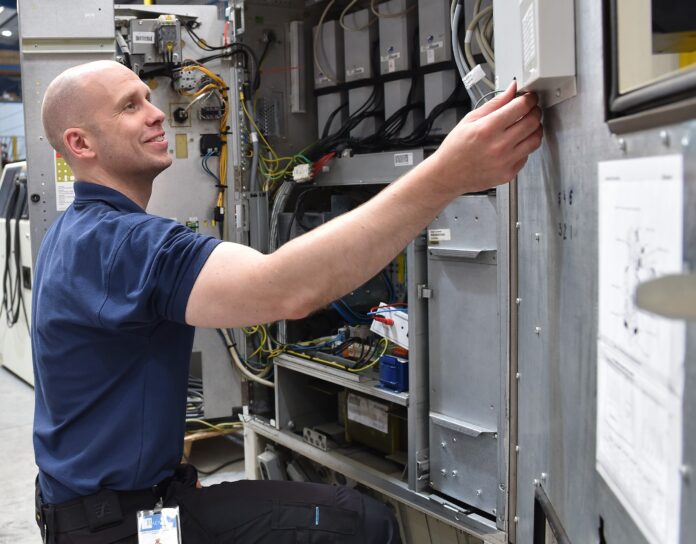Studies show predictive maintenance is now a mainstream strategy for businesses seeking to avoid the soaring costs of downtime. But with the majority of manufacturers still using factory equipment that is over ten years old, a balancing act is emerging between managing obsolescence, avoiding downtime, and meeting boardroom agendas both of productivity and ESG (Environmental, Social and Corporate Governance).
A report by Siemens, The True Cost of Downtime 2024, found the cost of downtime has gone up significantly, on average, across all industries over that last five years. According to the Siemens report, “unplanned downtime now costs the world’s 500 biggest companies 11% of their revenues. That totals $1.4 trillion equivalent to the annual GDP of a major industrial nation like Spain.”
But for many businesses today, increased downtime costs can also be put in the context of a recent white paper by ERIKS UK & Ireland and IET, which found that over 50% of equipment used in 65% of factories is over 10 years old and that more than 70% of companies have equipment with no OEM spares availability.
So, while there has been a huge focus from equipment manufacturers over the past few years about Industry 4.0 and IIoT (Industrial Internet of Things) as the answer to minimised downtime in the future, where does that leave the vast majority of companies now using legacy equipment? And how does that fit with the sustainability agenda, compelling companies to seek the most long-term performance from capital equipment?
When it comes to the ESG (Environmental, Social & Governance) agenda, choosing replacement parts over replacement systems reduces resource consumption, waste generation, and energy consumption. It is an approach that promotes the maintenance and extension of the life of products and systems in a more sustainable and responsible way, with benefits as follows:
Environmental Benefits
- Resource Efficiency: Using replacement parts preserves the functional components of systems in good condition, reducing the need for new raw materials.
- Waste Reduction: Replacing parts generates less waste than replacing entire systems and helps contribute to the circular economy.
- Lower Carbon Footprint: The production of replacement parts typically requires less energy and emits fewer greenhouse gases than the manufacturing of an entirely new system.
- Water and Energy Conservation: The production of replacement parts generally requires less water and energy compared to manufacturing new systems.
Social Benefits
- Local Economy Support: Replacing parts often means engaging local suppliers and repair services, supporting local economies and creating jobs.
- Consumer Trust: The use of replacement parts demonstrates a commitment to customer satisfaction by extending the life of products and systems.
Governance Benefits
- Resource Stewardship: Choosing replacement parts demonstrates responsible resource management and aligns with sound governance practices that consider the long-term impact of operations.
- Risk Mitigation: The use of replacement parts can mitigate some of the risks associated with replacing a system, such as disruptions in operations, compliance challenges, and reputational concerns.
- Transparency and Reporting: Incorporating replacement parts into sustainability strategies showcases commitment to transparency and responsible reporting, as it reflects a focus on minimizing environmental impacts.
These ESG benefits can be attained through a strategic approach that mixes predictive maintenance and obsolescence management into a combined plan in the following stages:
Risk Assessment
Risk planning is best carried out on a rolling timeline using an inclusive framework, taking into account any factors that can contribute to the likelihood and potential impact of obsolescence.
A usual starting point is simply to identify critical assets and then assess the risk of obsolescence in both qualitative and quantitative terms. Once the risks have been identified in relation to each asset, the next step is an assessment of obsolescence likelihood. Data for this can be gathered from everything from the maintenance logs and internal systems to the reliability of the supplier in terms of SLAs, service and support. Looking into suppliers’ end-of-line (EOL) plans can mitigate the risk of discontinued support or technology upgrades.
Repairs
What can be repaired in the event of a breakdown? Can you wait for a repair? For items that cannot have any downtime whatsoever, a repair may not be an option. For items such as HMIs, where very specific overlays are required to complete the repair, lead times can push timescales into weeks rather than days.
Determine at the outset who will carry out the repairs and what resources they have. Do they have a good track record? Will they do the work themselves, or outsource it? A quick company check will help narrow down the list of suppliers.
Spare Parts
What spare parts will be needed to ensure they are available swiftly? Do you have them in stock?
For items where you have ascertained that repair or upgrade is not an option, but the part is critical to your production, a spare should be kept in your stock so that in the event of a breakdown you can switch out the faulty unit in a matter of minutes. This mitigates downtime and gives you the option to repair the faulty unit and put it back into your stores, reducing future costs on spares management.
Buying spares at the right time can save you a lot of money compared to purchasing when you are already on breakdown and are factoring in express shipments from wherever the part is in the world, as well as the unit itself possibly being a lot more expensive due to its rarity now that it is obsolete.
Radwell recently launched SparesVault, a subscription-based spares inventory service, to provide fully outsourced spares management to address these types of challenges.
Strategy
Once all of the above is in place, it’s important to develop a strategy aimed at reviewing and renewing policies and procedures for these ongoing.
Upgrade
Finally, consider upgrades. Upgrading in the middle of unplanned downtime is never recommended so it is worth considering if the equipment can be upgraded before problems occur.
What equipment can be upgraded? What equipment should be upgraded and when? Simply having a plan answering these questions will help keep you ahead of the curve.
Due to their rarity, the cost of some obsolete parts can actually be more than double the cost of a modern equivalent. New equipment comes with warranty and is more readily available so you can be confident that you will receive ongoing support for a number of years.
Upgrades can also provide increased machine productivity, throughput and reliability and help reduce energy costs too.
AC drives are often a prime candidate for upgrading as the majority of applications are relatively straightforward and require only minor wiring modifications. For more complex applications there can be a reluctance to upgrade in a breakdown situation. It is often easier to go like for like but this isn’t always the best option. A good supplier should have the necessary skills to assist or even set up the replacement before shipping. Planning the upgrade in advance is always the best solution.
Pawel Berlicki is Operations Manager at Radwell Polska. Radwell International is a leading global supplier of surplus and remanufactured industrial control systems. With 17 locations worldwide, Radwell is an authorised distributor for over 350 new components and parts brands and also specialises in hard-to-source parts for the provision of refurbished industrial automation components.
Contact:
Radwell Polska, Unii Europejskiej 10, Oświęcim, 32-600, Poland
Tel: 0488880744
E-mail: PLsprzedaz@radwell.pl
Internet: www.radwell.pl






